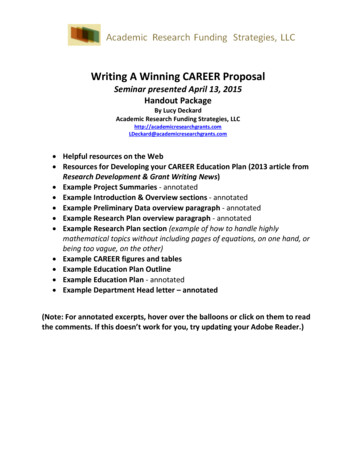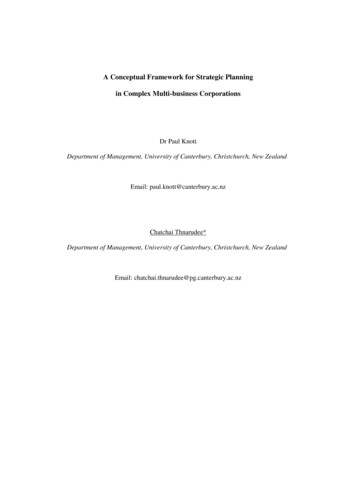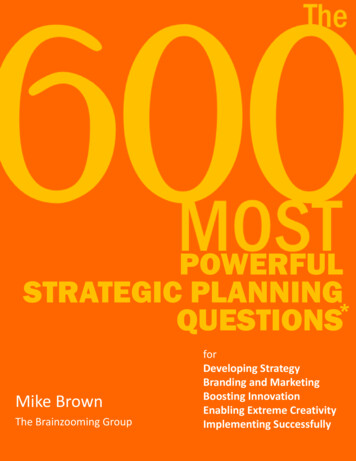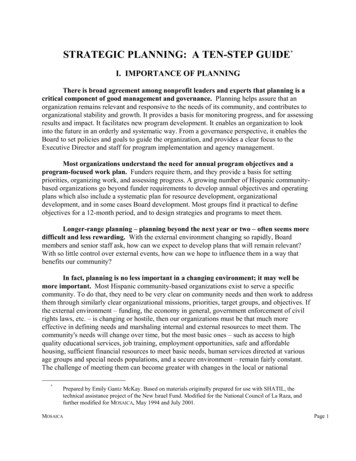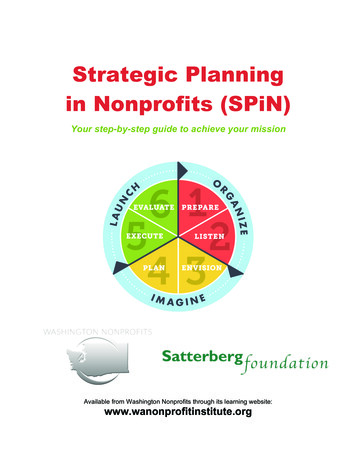
Transcription
Strategic Planningin Nonprofits (SPiN)Your step-by-step guide to achieve your missionAvailable from Washington Nonprofits through its learning website:www.wanonprofitinstitute.org
IntroductionStrategic Planning in Nonprofits (SPiN) is a project of Washington Nonprofits, our state association thatmakes sure nonprofits have what they need to succeed. SPiN was funded by the Satterberg Foundation.Together we seek to expand the capacity of nonprofits to achieve their mission. SPiN was designed to give youthe knowledge and tools your organization needs to plan so that you can better achieve your mission.These materials accompany videos and are supported by key tools and documents. Visit the StrategicPlanning in Nonprofits webpage for more:www.wanonprofitinstitute.org /planningStrategic Planning in Nonprofits is the third in a series of nonprofit learning resources. Some of the topicscovered here connect with topics covered in these other resources:Boards in Gear:Unlocking the Why, What,Who, and How ofNonprofit BoardsFinance Unlocked forNonprofits: Unlockingfinancial literacy fornonprofit board membersto deliver mission andprotect assetsLet’s Go Legal: The rightroad to compliance andprotection. Created inpartnership with Wayfind.All of these include videos, kits, games, documents, and tools.Available from The Washington Nonprofit Institute: www.wanonprofitinstitute.org.The Washington Nonprofit Institute is a project of Washington Nonprofits.Laura Pierce, Executive Director of Washington Nonprofits, served as the content expert for SPiN, and wegreatly appreciate the contributions of by our team of advisors: Angela Powell, Principal, Imago Sarah Tran, Executive Director, Nonprofit Assistance Center Catharine Gately, Founder, The Narrative CompanyFor more information:Washington hingtonnonprofits.org855-299-2922 2018 Washington Nonprofits. All rights reserved. www.washingtonnonprofits.org2
IntroductionWelcome to SPiN!Strategic Planning can seem intimidating. You may imagine months of meetings to produce a report that sitson the shelf. But when done well, planning serves as a powerful and effective blueprint for the future of yourorganization. In reality, you are probably already planning — many small nonprofits operate strategically everysingle day. You just may not be disciplined in putting your plans on paper.Before we get started, let’s define Strategic Planning. A “strategy” is a plan, method, or series of actionsfor obtaining a specific goal or result. In nonprofits, the right strategic alignment of people, funds,resources, and partnerships leads to success.According to the National Council of Nonprofits, “A Strategic Planning Process identifies strategies so thata nonprofit will achieve its mission. Ideally as staff and board engage in the process, they becomecommitted to measurable goals, approve priorities for implementation, and also commit to revisitingthe organization’s strategies on an ongoing basis as the organization’s internal and externalenvironments change.”A Strategic Plan has the power to: Focus and align board and staff members, creating better results and increased momentum. It opens aconversation that may not be otherwise happening. Connect and unify your stakeholders — those individuals or groups that have an interest in theorganization, including those people who benefit from your mission. Give you the words to use with your key audiences (like funders and partners) to bring them morepowerfully into your work.Having a Strategic Plan is critical to driving your mission. You will discover that taking the time to reflect andhave meaningful conversations about your strategic direction is powerful and inspirational, and may have otherbenefits such as inspiring others, engaging new leaders, improving your work, raising more funds, anddeepening your relationships with community partners and those you serve. We look forward to working withyou on the journey!SPiN FormatThe following guide is our core SPiN curriculum and covers each stage of the Strategic Planning process. Ineach section, we explain what your Strategic Planning Team needs to know and do, including:Why is this stage of planning important?What does your Strategic Planning Team need to know? 2018 Washington Nonprofits. All rights reserved. www.washingtonnonprofits.org3
IntroductionHow does your Strategic Planning Team show what they know?What actions should you expect at this stage?What will your Strategic Planning Team produce at this stage?What are the tools your Strategic Planning Team can access and leverage to complete thisstage?What are some ideas that work?The SPiN CycleStrategic Planning is cyclical. You reflect, chart a course (plan), implement your goals, learn from theexperience, and then start all over again — each time making progress toward your vision and mission. Werecommend completing the cycle every three years. The graphic below illustrates the main stages of theStrategic Planning Cycle, and of our SPiN Toolkit. 2018 Washington Nonprofits. All rights reserved. www.washingtonnonprofits.org4
IntroductionStrategic Plan ComponentsThe basic components of a strategic plan are mission, vision, strategic priorities and objectives. Themission, vision and strategic priorities form your organization’s strategic framework. This is a high-level“compass” to provide direction. The strategic framework is short and memorable (usually one page) and canbe shared with the public. The framework is supported by a more detailed implementation plan that outlineshow you expect to achieve the results outlined in the strategic framework, and includes specific andmeasurable objectives. SPiN will guide you through the development of each element.Elements of a Strategic PlanElementDefinitionMissionA statement of the organization’s purposeVisionA statement of what the world will be like whenyou have achieved your missionStrategicPrioritiesMajor goals for the coming three years — themost important areas of focus for yourorganization during this planning periodObjectivesSpecific steps to take to make progress towardeach strategic priority.Some additional elements you might consider include values, an identity statement, and outcomes.Building a Strategic Planning TeamYour board of directors has ultimate responsibility for strategic planning. In practice, planning is a sharedresponsibility of board and staff and can be enhanced by participation of clients and other communitystakeholders. We recommend identifying a small team of leaders to guide the process and keep it moving. Thisgroup does not make all the decisions, but they can gather information and tee up board and staff discussionsthat form the basis for the plan. They can develop and edit the draft plan for board review. Your board shouldformally approve the final strategic plan. This core planning team typically includes several board and staffmembers and may include one or two other key stakeholders whom you feel can add value.Depending on the culture of the organization, your planning process may be more staff-driven or board-driven,but the ideal is to engage both groups throughout the planning activities.Ready to begin?You'll need some tools along the way.They're available on our website,www.wanonprofitinstitute.org. 2018 Washington Nonprofits. All rights reserved. www.washingtonnonprofits.org5
1. PrepareSPiN: Strategic Planning in NonprofitsORGANIZE1PREPARESTARTDo you have aprior/existing plan?NOLearn about planning anddecide if it’s useful to youYESYES Review progress& accomplishmentstowards plan goalsSecure board commitmentto participate activelyin planning Assess usefulness& decide what tocarry forwardNONOSTOP! Put yourenergy elsewhereSTOP!YESGET READY! Form planning Team Develop a timeline Identify key questions Write brief org. historyCONTINUE TOLISTEN STAGEWASHINGTONNONPROFITS.ORG 2018 Washington Nonprofits. All rights reserved. www.washingtonnonprofits.org6
1. PrepareSPiN: Strategic Planning in NonprofitsA key to successful Strategic Planning is “planning to plan.” To achieve a thoughtful plan thatis truly strategic, you’ll need an effective process that is inclusive, transparent, and wellinformed.Strategic Planners know at the PREPARE stage that:1. They understand the energy and time required to complete a quality plan and setaside the appropriate time and resources. You may need to advocate for the value ofStrategic Planning in order to gain buy-in and commitment from other organizationalleaders. Be honest about what is required. If the organization is facing a crisis, work toresolve it before launching strategic planning.2. They build on any existing plan elements. Do you like your current mission statement,or does it need revision? If you have a prior strategic plan, clarify your progress andaccomplishments and decide what to carry forward.3. They know that there are different approaches to strategic planning. These include:Classic Planning, Scenario Planning, Real-time Strategic Planning (La Piana Method),and more. Check our bibliography to learn more. Bottom line: there are lots of tried andtrue methods, but no one way to plan. This kit focuses on a classic approach that workswell for most organizations.4. They scale their efforts to the organization’s scope and stage of development.Evaluate your goals and desired pace, determine the amount of outreach you want toconduct during the process, and consider hiring a professional consultant to serve as aguide to reduce organizational workload and keep the process moving.5. They know their organizational history. Write a short 1-2 page narrative that can beincluded in your final plan as background for all individuals involved in your organization.6. They identify key questions facing the organization. Hold early discussions withboard and staff to identify important issues to address.Strategic Planners demonstrate what they know in these ways: The Board of Directors and Executive Director are active participants in the planningeffort; Consideration has been given regarding the amount of time required to devote toStrategic Planning in light of the organization’s current and projected calendar; A diverse Planning Team has been formed to lead the process; and Consideration has been given to whether an outside professional is needed to help guidethe process. 2018 Washington Nonprofits. All rights reserved. www.washingtonnonprofits.org7
1. PrepareSPiN: Strategic Planning in NonprofitsStrategic Planners produce these documents at the PREPARE stage ofplanning: Agenda for first Strategic Planning Team meeting Roster and contact information for Strategic Planning Committee Timeline/Schedule Brief Organization History List of key questions identified by board and staffThere are a few key tools that might help you produce these documents: Questions to Ask Before Starting Strategic Planning Sample Agenda for First Strategic Planning Committee Meeting Strategic Planning FAQ Sample TimelineThese ideas have worked for other Strategic Planners: Look online or ask partner organizations to see their strategic plans. Reviewing somesamples can help you decide how you want your strategic plan to look and give you amodel to work toward. Hold a strategic planning launch where you explain the process you have planned andthe roles that board and staff will play. Alternately, create a Joint Sponsorship Letter fromthe Executive Director and the Board Chair outlining the process and timeline as wellopportunities for input. Circle the letter to board, staff and key stakeholders. Write down your organization’s origin story, if it isn’t documented already. How and whydid the organization start? Learn about organizational life cycles and tailor your planning process to the stage ofdevelopment that your organization is currently in. Check our bibliography for books thatwill help you understand common challenges and opportunities associated with eachdevelopment stage, and factor that information into your planning. 2018 Washington Nonprofits. All rights reserved. www.washingtonnonprofits.org8
1. Prepare 2018 Washington Nonprofits. All rights reserved. www.washingtonnonprofits.orgSPiN: Strategic Planning in Nonprofits9
2. ListenSPiN: Strategic Planning in Nonprofits2ORGANIZELISTENSTART1. List StakeholdersDo we know what they think?YESGatherexisting infoNO2. Gather DataDO STAKEHOLDER LISTENINGDEVELOP STAKEHOLDER OUTREACH PLANCONDUCT LISTENING ACTIVITIESCREATE A SUMMARY OF INPUTDo we understand our financialposition & funding model?Complete financial analysisNOYESDo we understand our organization’sstrengths & weaknesses?NODo an org healthcheck upCompileinfo into apacket forboard &key staff,to informdecisionsduringplanning-ORYESDo a SWOT analysisFocus on other areasCONTINUE TOENVISION STAGEWASHINGTONNONPROFITS.ORG 2018 Washington Nonprofits. All rights reserved. www.washingtonnonprofits.org10
2. ListenSPiN: Strategic Planning in NonprofitsWhen an organization’s leadership knows about the people you serve and other relevantdata about your program and organization, your strategy improves, and you gain respectamong your key audiences. You will be able to tell your story better, and your relationshipsand community impact will grow.Strategic Planners know at the LISTEN stage that:1. Input from key stakeholders (all the different people or groups that have a stake inyour success) is a vital part of Strategic Planning. Asking for input yields informationand insights that lead to a better plan and engages clients, donors, and others in thenonprofit’s sphere in powerful ways. Focus groups, community meetings, interviews, andonline surveys are ways to listen to stakeholders.2. Your organization’s overall health matters. Completing an analysis of your financialhealth and/or an organizational assessment will inform planning.3. There are other organizations working in the same space as you, whether in acompetitive way or as partners. Your organization’s position within the larger landscape isa key consideration.4. You will never have perfect or complete information. While research and stakeholderlistening is worthwhile and important, you will never have the time, energy, and resourcesto consult all possible stakeholders or know all there is to know about your field orcommunity. Do a realistic amount of listening and learning before moving into thedevelopment of your plan.Strategic Planners demonstrate what they know in these ways:A. The Planning Team has developed a list of stakeholders—key constituency groups—andtaken steps to solicit input from them. The input is summarized in a way that the boardand staff can learn from it.B. The Board and Staff has honest and clear sense of the organization’s current strengthsand weaknesses, reputation and position in the community.Strategic Planners produce some or all the following documents at this stage: Summary of stakeholder input Summary of organizational strengths and weaknesses and financial position Inventory of program goals and outcomes SWOT AnalysisThere are a few key tools that might help you produce these documents: Stakeholder Engagement Primer Sample Stakeholder Outreach Plan Nonprofit Snapshot SWOT Analysis Worksheet 2018 Washington Nonprofits. All rights reserved. www.washingtonnonprofits.org11
2. ListenSPiN: Strategic Planning in NonprofitsThese ideas have worked for other Strategic Planners: Hold a large community meeting to solicit input from all your stakeholders at one time.Get different constituents talking to each other to encourage out-of-the-box thinking aboutwhere your organization could go in the future. Recognize that you are part of a larger movement for change. Spend some time talkingabout (or with!) collaborators and competitors. Explore what you admire about each ofthem and how your organization could help them do that better. Learn about bestpractices in your field. 2018 Washington Nonprofits. All rights reserved. www.washingtonnonprofits.org12
2. Listen 2018 Washington Nonprofits. All rights reserved. www.washingtonnonprofits.orgSPiN: Strategic Planning in Nonprofits13
2018 Washington Nonprofits. All rights reserved. www.washingtonnonprofits.org"System" repsFormer boardmembersFormer donorsDonorsVolunteersClientsBoardStaffStakeholder typeHow manyto target?SPIN: Strategic Planning in NonprofitsStakeholder Outreach PlanNameOrganizationType of contactAssigned to contactPhoneEmailStatusNotes2. ListenSPiN: Strategic Planning in Nonprofits14
2. ListenSPiN: Strategic Planning in NonprofitsSPiN: Strategic Planning in NonprofitsNonprofit SnapshotA quick quiz to take the pulse of your organization’s systems and practicesGovernanceYesNoYesNoYesNoYesNoDo you have a clear mission statement that guides your leadership?Do you have an organizational chart that includes the board of directors?Are board members aware of the organization's mission and programs?Does the board hold regularly schedule board meetings and/or committee meetings?Are there written expectations and responsibilities for board members?Are board members recruited through a transparent process?Do board members contribute to the health of the organization?Do you have a conflict of interest policy signed by board members?Do board members represent the different demographic groups related to your missionand its implementation?Human ResourcesIs there an organization chart that describes the roles of staff members?Are staff members aware of the organization's mission and programs?Are there written job descriptions for each staff member?Does the staff hold regularly scheduled meetings?Do staff members receive orientation at the start of their employment?Do staff members receive regular professional development?Are staff members evaluated?Is there a succession plan in place for the director and top organization staff members?Do you track how many people volunteer during a one year period?Are volunteers oriented and supported?CommunicationIs there a communication plan in place?Does your communication include information for donors about impact and finances?Do you have an annual report?Do you have a donor services system that includes tracking actual and potential donors,tracking money received, thanking donors, and following up some time later with impactstatements?Do you have a social media outreach plan that grows your community?Is every member of your board and staff able to speak in a compelling way about yourmission?PlanningDoes the organization have a strategic plan (or other organizational work plan)?Did board members contribute to this plan?Did staff members contribute to this plan?Is a regular needs assessment of the community performed with written documentation?Does the organization have a technology plan?Do major programs have a business plan that aligns them with the organization’smission and funding reality? 2018 Washington Nonprofits. All rights reserved. www.washingtonnonprofits.org15
2. ListenSPiN: Strategic Planning in NonprofitsNonprofit Snapshot, page 2EvaluationYesNoYesNoYesNoDo you know how many people your organization serves? Has served since itsfounding?Is there an evaluation plan in place that measures the impact of programs in the shortand long-term?Do you track indicators that would prove achievement of the organization's mission?Are these indicators reviewed annually/regularly?Are program participants tracked in a database?Is evaluation a topic during regular staff meetings?Is information gathered through evaluation used in program design?Is information gathered through evaluation used in communications with donors andextended community?Financial OverviewDoes the organization have an annual budget?Does the organization review the budget after six months?Does the organization prepare a bank reconciliation on a monthly basis?Does a qualified bookkeeper manage the organization's money day to day?Does a different person from the bookkeeper sign checks?Does the organization have at least two signatories on the bank account?Does an accountant—or someone with accounting experience— serve as theorganization's treasurer?Does the executive director review expenditures on a monthly basis?Does the organization have a printed organization receipt book?Are payments made by check?Does the organization have a clear system for managing cash?Is the accounting function computerized (using a program like Quicken or Quickbooks)?Is funding stable and from a diversity of sources?Risk ManagementDo you maintain minutes of all board meetings?Do you file all of the necessary tax documents (local, state, federal)?Do you maintain necessary records at necessary levels of government to show nonprofitstatus?Do you maintain enough insurance to protect the organization’s assets?Do you maintain employment records?Do you pay all necessary employment taxes?Do you maintain technology safeguards, including backing up systems and viruscontrol?Do you maintain a central listing of organization passwords?Do you track grants to ensure proper handling of funds?Are all formal partnerships clearly outlined in signed agreements?Are you protected against patent/copyright infringement?Is all documentation related to property up to date? 2018 Washington Nonprofits. All rights reserved. www.washingtonnonprofits.org 2016 Washington Nonprofits. All rights reserved. www.washingtonnonprofits.org16
2. Listen 2018 Washington Nonprofits. All rights reserved. www.washingtonnonprofits.orgSPiN: Strategic Planning in Nonprofits17
3. EnvisionSPiN: Strategic Planning in NonprofitsIMAGINE3ENVISIONSTART1. Evaluate yourMission StatementWE LOVE IT!Keep currentmission statementMEHReview & reviseMission StatementVet Mission & Visionwith board and staffMission & VisionCOMPLETE!2. Create a Vision StatementCONTINUE TOPLAN STAGEWASHINGTONNONPROFITS.ORG 2018 Washington Nonprofits. All rights reserved. www.washingtonnonprofits.org18
3. EnvisionSPiN: Strategic Planning in NonprofitsWhen your organization invests time to develop or renew a powerful mission and vision, youwill: Be able to answer the questions “Who are we?” and “Why do we exist?” Have a strong connection to your organization’s core purpose Set the stage for a strong, well-grounded strategyStrategic Planners know at the ENVISION stage that: You are expressing your core purpose and philosophy through your mission andvision, and that this will guide and inspire your work. Some think of these elements astheir “North Star.” Your Mission Statement communicates why your organization exists and what youdo. It should be compelling, concise and memorable. Resist the temptation to spendmonths on your mission, wordsmithing it to the point where people lose their passion toplan. A board or committee conversation is great at the start, but the final product may needto be written by fewer people. Everything in the Strategic Plan ultimately ties to achieving your Mission. Throughoutthe planning process, you know to ask yourself, “Are we using our people and resources inthe best possible way to deliver on our mission?” Vision and Values can help guide everything you do. The vision statement is astatement of what the world will be like when you have achieved your mission. Valuesaffirm what the people in the organization believe and can guide decision-making. (Caution:developing a written values statement can be time-consuming, so you may want to omit thisstep from your first planning effort).Strategic Planners demonstrate what they know in these ways:A. They have reflected on what they learned in the LISTEN stage of planning and havedeveloped greater clarity around who they are and why they exist.B. This reflection gets integrated into the development of a clear and succinct mission andvision.C. The full board approves the mission and vision once it has been developed. This is a keystep before the committee moves on to the PLAN stage.Strategic Planners produce these documents at the ENVISION stage of planning: Mission statement Vision statementThere are a few key tools that might help you produce these documents: Mission Statement Worksheet Mission and Vision Statements – Definitions & Examples 2018 Washington Nonprofits. All rights reserved. www.washingtonnonprofits.org19
3. EnvisionSPiN: Strategic Planning in Nonprofits Mission Statement Assessment Tool Group Exercises to Liven Up PlanningThese ideas have worked for other Strategic Planners: In addition to mission, vision and values, some organizations add an identity statement totheir strategic framework. See our resources for information on creating an identitystatement. There are many exercises that help people generate creative ideas that can beincorporated into your plan. See Group Exercises to Enliven Planning in our resourcesection. 2018 Washington Nonprofits. All rights reserved. www.washingtonnonprofits.org20
3. EnvisionSPiN: Strategic Planning in NonprofitsMission StatementsThe Good, the Bad and the UglyA mission statement is your organization’s purpose. It is: Short and Memorable (”sticky”)Jargon FreeContains superhero (eg. action) verbs Invokes curiosityStates “what you do” and “why you doit” (and NOT “how you do it”)Rating GuideGood statement meets most of the criteriaBad statement meets some of the criteria but has room for improvementUgly statement breaks every rule of a good mission statementNote: Organization names have been disguised to protect the innocent.Mission StatementGoodBadUglyNotesProvides education, training, and health services tovulnerable Afghan women and children in order to fosterself-reliance, critical thinking skills, and communityparticipation throughout Afghanistan and Pakistan.To conserve the lands and water on which all lifedepends.WHIZ is growing the movement of leaders who work toensure that kids growing up in poverty get an excellenteducation.Our mission is to enhance the lives of people living inimpoverished communities in other countries and enrichour lives through meaningful relationships, service andlearningPAN improves the lives of vulnerable Peruvian womenand children through education, training, and healthservices.NABS a diverse network representing dental careinterests in Barnstable County developing partnershipswith providers, to identify challenges, strategies, andopportunities to improve patient outcomes for allresidents.”We are dedicated to strengthening families andindividuals by providing a wide range of social servicesand programs, including therapy, information andreferral, support, education and advocacy.Ideas worth spreading. 2018 Washington Nonprofits. All rights reserved. www.washingtonnonprofits.org21
3. EnvisionSPiN: Strategic Planning in NonprofitsSPiN: Strategic Planning in NonprofitsMission Statement Assessment ToolYour mission statement has an important job: It answers the question “What do you do?” This Cosmo-stylequiz will help you decide whether it needs a quick spruce or major overhaul.This quiz is based on the teaching and writing of the totally awesome Erica Mills of Claxon Marketing. I thinkthe quiz is pretty fun, but if you want to save time or learn directly from the master, skip to the resourcessection. Ready? Let’s go!Write your mission statement from memory in the box below. DO NOT LOOK IT UP. If you don’tremember, do your best.Okay, now look it up and write it word for word in this box.1. Did you have it memorized?A. Word for wordB. More or lessC. Kind of?D: Not even close2. How many words are in your official mission statement?A. 8-15B. 16-30C: 31 or more3. Go to https://readability-score.com/text/ and type your mission statement into the box.Check the column on the right: What’s the Flesch-Kincaid Readability Score?Look below the Flesch-Kincaid Score. What’s the average grade level?4. Circle all the verbs in your mission statement. How do they make you feel?A. Energized! I love these verbs! B. I have no opinions about these verbs C. These verbs put me to sleep 2016 Washington Nonprofits. All rights reserved. www.washingtonnonprofits.org 2018 Washington Nonprofits. All rights reserved. www.washingtonnonprofits.org122
3. EnvisionSPiN: Strategic Planning in NonprofitsSPiN: Strategic Planning in NonprofitsMission Statement Assessment Tool5. Do you use the verbs “support” or “provide”?YesNo6. Say you mission statement out loud. How did it feel?A. It rolled right off my tongueB. Okay, but not really naturalC. I felt silly saying itIt’s time to tally up your score. More points, better. Fewer points, not as good.1. A 4 points, B 3 points, C 2 points, D 1 point2. A 3 points, B 2 points, C 1 point3. Flesch-Kincaid: 0-40 1 point, 41-60 2 points, 61-100 3 pointsAverage grade level: Above 12 1 point, 9-12 2 points, 5-8 3 points4. A 3 points, B 2 points, C 1 point5. Yes 0 points, No 1 point6. A 3 points, B 2 points, C 1 pointWhat does it all mean?This assessment is not the definitive evaluation of your mission statement. Remember, your mission answersthe question “What do you do?” A statement that doesn’t do its job doesn’t help you. Read on to learn someways to improve your mission statement. Then, decide if they make sense for your org. If you need a majoroverhaul, check out the resources section.Question 1: Is your mission statement easy to remember?For more information on take-aways, why your mission statement matters, and tipsTake-away: Want a memorable mission statement? Keep it simple.and tracks, please find the “Mission Statement Assessment Tool” onWhy it matters: When someone asksunder“WhatChapterdoes your3.org do?” you want to answer without fishing around inwanonprofitinstitute.org/planningthe depths of your brain. Most forgettable mission statements are too long and too complicated. They try to tellpeople everything your organization does in one sentence. That may seem like a good idea, but as Erica says,“If you tell someone everything
Strategic Planning in Nonprofits (SPiN) is a project of Washington Nonprofits, our state association that makes sure nonprofits have what they need to succeed. SPiN was funded by the Satterberg Foundation. Together we seek to expand the capacity of nonprofits to achieve thei
